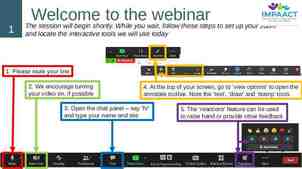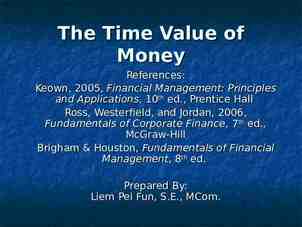ISO INTERNATIONAL ORGANIZATION FOR STANDARDIZATION
64 Slides432.00 KB
ISO INTERNATIONAL ORGANIZATION FOR STANDARDIZATION
I.S.O. or ISO? ISO is not an acronym, but was derived from a Greek word “isos” meaning “equal”. The relation to standards is that if two objects meet the same standard, they should be equal. The International Organization for Standardization is a voluntary organization whose members are recognized standard authorities, each one representing one country. The American National Standards Institute (ANSI) is the United States Representative to ISO. ISO Main Headquarters in located in Geneva, Switzerland.
Some History (AQAP) Allied Quality Assurance Publication.WW11. A series of publications on everything from production efficiency to selection of suppliers. AQAP Series was adopted by the UK Ministry of Defense for the British Arms Forces. A trickle down effect was more organizations began to require Quality Assurance Programs from their Suppliers. 1979 British Standard (BS) 5750 adopted based largely on the AQAP Series. The British version addressed the diversity issues emerging in the requirements for different organizations.
More History BS 5750 was so effective, it was adopted with very little changes by ISO in 1987 as ISO 9000. The formation of the European Union and the perception that it (ISO) was required in order to do business with Europe, lead to the widespread acceptance of the ISO series.
MIL-Q-9858 & MIL-I-45208 USA ONE SIZE FITS ALL APPROACH NO ALLOWANCE FOR INNOVATIONSPROCESS MATURITY POTENTIAL CUSTOMER COST SAVINGS LOST DETAILED DESIGN SPECS REPLACED WITH PERFORMANCE-BASED SPECS. IN 1996, THESE MODELS WERE SUPERCEDED WITH ANSI/ASQC Q-9000 SERIES
Commercial- Military Integration 1994-Acquisition Reform Reduce total ownership costs Reduce acquisition time Promote standardization of materials, facilities,and engineering practices to improve military readiness
Defense Standardization Program Gov’t unique specifications were a barrier to commercial-military integration Cancelled or inactivated thousands of documents Greater reliance on the use of nongovernment standards
Every ISO Member Body is responsible for: Informing potentially interested parties in the country of relevant international standardization opportunities/initiatives Ensuring that a concerted view of the country’s interest is presented during international negotiations leading to standards agreement Providing their share of financial support for the central operations of ISO, through the payment of membership dues Representing vendors, manufacturers, consumers, professionals and government of it’s country
Other Members Correspondent Member-usually an organization in a country which does not yet have a fully developed national standards activity. Do not take an active part in the technical and policy development work, but are kept fully informed about the work of interest to them Subscriber Membership-established for countries with very small economies. Subscribers members pay reduced membership fees that nevertheless allow them to maintain contact with international standardization.
How is it financed? Membership dues-80% Sales of Standards and other Publications-20% Subscriptions are expressed in units and calculated in Swiss francs Factors affecting dues: gross national product (GNP) and Value of imports and exports Others expenditures: Voluntary time and travel for approx. 30,000 experts (several hundred million Swiss francs per year)
Who does the work? A highly decentralized hierarchy of some 2850 technical committees, subcommittees and working groups. Hence the 30000 experts. The premise is that equal partners come together in the resolution of global standardization problems Qualified representatives of; industry research institutes government authorities consumer bodies international organizations from all over the world
The Goal of ISO Enhanced product Quality and Reliability at a reasonable price Improved health and safety and environmental protection and reduction of waste-(ISO 14000) Greater compatibility and interoperability of goods and services Reduction in the number of models and thus, reduction in costs Increased distribution efficiency and ease of maintenance Simplification for improved usability
ISO and WTO Strategic partnership-common goal of promoting free and fair global trading WTO agreements require underpinning by technical agreements (ISO) ISO recognized by WTO for special technical support in relationship to new and expanded WTO programs
Regional Partners ISO has recognized regional standards organizations representing: Africa The Arab Countries Commonwealth of Independent States Europe Latin America The Pacific area South-East Asia Nations
(Some) ISO “Achievements” ISO Film Speed Code-among photographic equipment standards, it has been adopted worldwide to make things simpler for the user Internationally Standardized Freight Container-air, sea railways,highways packages interface efficiently. Other standardized documents identifying sensitive or hazardous cargoes making international trade cheaper, faster and safer. clear cut message in a multi-lingual world. These symbols are displayed in automobiles over the world, no matter where they were produced. Telephone & Banking Cards- standardization of the format means that they can be used worldwide Paper Sizes-With ISO 216, standard paper sizes allow economies of scale with cost benefits to both producers and consumers Symbols for Automobile Controls-well designed symbol conveys a 12,000 International Standards- more than 300,000 pages in English and French with terminology provided for other languages Others: Automobile bumper heights, sizes and colors of road signs, hygiene and toxicity in the food industry, nut /bolts combinations, light measurement in photography, child resistant packaging,standards for monitoring the state of the environment and standards for safety of machinery and protective clothing
ISO 9000 Series ISO 9001-applies to organizations that design, develop, produce, install and service product (Tenergy Water, for instance) 20 sets of Quality System Requirements (Elements) ISO 9002-applies to organizations that produce, install and service product 19 sets of Quality System Requirements (Elements) ISO 9003-applies to organizations that assure Quality through Final Inspection and Testing. 16 sets of Quality System Requirements (Elements) (missing 4.4, 4.6, 4.9 and 4.19)
What exactly is ISO 9001? A series of Standardized Quality System “Frameworks” which are designed to detect and prevent Quality problems. There are 20 Elements in the ISO 9001 Standard. Each element outlines Quality issues which the company is required to address as part of the Quality System in order to be certified or compliant.
The Elements 1. Management Responsibility 2. Quality System 3. Contract Review 4. Design Control 5. Document and Data Control 6. Purchasing 7. Control of Customer Supplied Product 8. Product Identification and Traceability 9. Process Control 10. Inspection and Testing 11. Control of Inspection, Measuring & Test Equipment 12. Inspection & Test Status 13. Control Of Nonconforming Product 14. Corrective & Preventive Action 15. Handling, Storage, Packaging, Preservation & Delivery 16. Control of Quality Records 17. Internal Quality Audits 18. Training 19. Servicing 20. Statistical Techniques
4.1 Management Responsibility Commitment Overall Plan Steering Committee Quality Objectives Management Review Appoint a senior executive ( The management Representative) to manage the quality system and give him/her the necessary authority to maintain it
Management Responsibility 2 Define a Quality Policy. Policy should describe company’s attitude towards Quality Identify and provide resources for people to manage, perform and verify Quality System work Define Quality System responsibilities; insure Quality System personnel have the authority to carry out these responsibilities and ensure that interactions between these personnel are clearly specified. Document this well. Define a procedure that Senior Managers can use to review the effectiveness of the Quality System
4.2 Quality System Develop the Quality System A manual that describes it Procedures, processes that are consistent with Quality Policy Quality plans to show how you intend to fulfill quality system requirements Develop plans for product, processes, projects and Customer Contracts
4.3 Contract Review Determine Requirements Procedure to ensure that all contractual requirements are acceptable before agreement to provide product to customer System for documenting review of customer contracts and sales orders Procedure to amending contracts and ensuring changes are communicated throughout the organization
4.4 Design Control Procedures to control the design and development process Identify groups involved and communication methods Procedure to control design outputs Design outputs at all stages verified Design modifications-how are changes implemented? Design inputs identified, documented, reviewed, flaws and deficiencies are resolved
Design Control 2 4.4.1 General 4.4.2 Design and development planning 4.4.3 Organizational and Technical Interfaces 4.4.4 Design Input Design Output Design review Design verification Design validation Design Changes
4.5 Document & Data Control Develop procedures to control quality system documents, records and data Procedures to review, approve and manage all quality system documents, records and data Procedures to control changes to documents and data
4.6 Purchasing Supplier Selectionbased on capability, performance history Customer Requirements Flowdown Ensure P.O.’s document precisely what to buy Purchase Order change control Procedures to verify the acceptability of purchases to you and the Customer List of Approved Suppliers-procedure to add or delete from the list Use of approved Suppliers
4.7 Control of Customer Supplied Product Correct & undamaged when received Record & report to Customer damage, etc. Traceable ownership Identification and Use Protect and Maintain (how & who) Dispose as Customer directs
4.8 Product Identification and Traceability Identify and document products at every step from purchase through all stages of handling, storage, production, delivery, installation and servicing Prevent product mixing Trace product or product batches by means of unique identifiers and record keeping
4.9 Process Control Develop procedures to plan, monitor and control production, installation and servicing processes Develop a record keeping system that monitors and controls process personnel and equipment Insure that all important processes qualities are monitored and recorded
4.10 Inspection & Testing Quality Plan-decide where, when and how-(incoming, in-process and final inspections) How records are maintained Identification (Acceptance/Rejection) Disposition (Acceptance/Rejection) Procedures to ensure product meets all requirements prior to shipping
4.11 Control of Inspection, Measuring & Test Equipm’t Develop procedures to control, calibrate and maintain inspection, measuring/test equipment (hardware and software) Ensure measurement equipment is appropriate, effective and secure Calibration procedures for all quality measuring and test equipment
4.12 Inspection & Test Status Identify conformance status-accept/reject at all points of production process The test status of the product is documented and respected throughout the production, installation and service process
4.13 Control of Nonconforming Product Prevent from unintended use Documented Identify and segregate Disposition by qualified personnel (MRB) Observe contractural or regulatory limitations Identify root cause of defect Record of dispositions Reinspect/retest after rework and repair
4.14 Corrective and Preventive Action Implement at root cause of defect Identify effectivity-date, lot, batch Identify responsibility for the problem Commensurate with the magnitude of problem and risks encountered Anticipate problems-preventive action Ensure effectivity of corrective/preventive actions
4.15 Handling, Storage, Packaging, Preservation & Delivery Methods to prevent damage or deterioration through all stages of production Designate storage areas Periodic assessment of material in storage Identify shelf-life sensitive items Protect to destination when required
4.16 Control of Quality Records What records are “Quality Records”? How long to retain, where, how? Define storage conditions Customer availability Hard copy or electronic media Protect from unauthorized access and subsequent alteration
4.17 Internal Quality Audits What we say we do Measure performance of the Quality System Scheduled events performed by qualified auditors independent of their functions Objective evidence Report to management for review Discuss with auditee Timely and appropriate corrective action Follow up for effectiveness
4.18 Training Identify needs Who to train? Who will provide the training? How will training be provided? Quality system training What is training schedule? How will training effectiveness be measured? What training records will be generated?
4.19 Servicing Installation Returned product-not defective Technical information Trained personnel Procedures, materials, equipment Train customer personnel
4.20 Statistical Techniques Establish, control & verify process capability Measure product characteristics Defined by qualified personnel Documented procedures
WHY DO WE NEED IT? can be Customer driven. Inspires more confidence in products and services that conform to the same standards Improves internal controls Increases employee involvement provides a competitive edge
Benefits for me? Potential increase in business volume which means job stability Outlet for ideas affecting Quality More control of your job Decrease in uncertainty of expectations Less stress
Does it change how we do things? No, in most cases. It means we document what we are already doing. “Document what you do and do what you say you do.” There would be some areas that will require written procedures to meet certain specific requirements.
The Process(in a nutshell) Create procedures Independent third that meet the ISO party audit Model for a Quality conducted by a Management Registrar for System certification Train internal Maintain quality auditors to perform system. Audited system audits. every six months to remain certified
ISO 9001:2000 Process Model
ISO 9001:2000 Why are standards being revised? What are the major changes? What do we do now?
When will it happen? Final standard release is scheduled for December 15, 2000. In three (3) years from the actual publication release, ISO 9002 and ISO 9003 and all associated guidelines will be history. ISO 9001 Quality Management Systems will have to be amended to comply with the new standard.
Why the need for change? ISO required 5-year standards review Difficult for small businesses Oriented towards manufacturing Proliferation of guideline standards Need to reduce documentation
Some Changes ISO 9001-ISO 9002-ISO 9003 (3 Stds) will become ISO 9001:2000 (1Std) 20 Sections(Elements) Structure will become main 5 Sections based on 8 Principles From a Quality Management System to a Business Management System
KEY NEW REQUIREMENTS Process oriented/continual improvement Increased emphasis on role of Top Management Consideration of legal and regulatory requirements Establishment of measurable objectives/planning Determination of training effectiveness Measurement and analysis of system performance (process and product) Monitoring of information and customer satisfaction dissatisfaction Increased attention to resource availability
Let’s make believe Contract Review-procedures to assure your customer needs and expectations are converted to Customer Requirements Established employee awareness and training programs Defined processes for evaluating the training program’s effectiveness Defined processes for internal communication
More make believe Defined processes for communicating with Customers regarding: product information, order handling, and processing, customer complaints and customer feedback. Added employee communication and training processes to create awareness of Customer requirements and importance of meeting them Defined processes to measure Customer satisfaction, which may include existing Customer complaint process
A few more Defined processes for collection and analysis of quality performance data, and use of the data to facilitate continual improvement Established Quality objectives and plans to support the Quality Policy Specific quality policy language to include a commitment to continual improvement
Principle 1-Customer Focused Organization Quality Management Principles APPLICATION FOR ISO 9001 (1994 EDITION) QUALITY MANAGEMENT APPLICATION (ADDITIVE TO ISO 9001) Principle 1 - Customerfocused organization Assure conformance to defined customer requirements. Understand current and future customers needs and expectations. Measure customer satisfaction and act on it. Organizations depend on their customers and therefore should understand current and future customer needs, meet customer requirements and strive to exceed customer expectations.
Principle 2-Leadership Principle 2 - Leadership Leaders establish unity of purpose and direction of the organization. They should create and maintain the internal environment in which people can become fully involved in achieving the organization's objectives. Set policy and verifiable objectives, deploy policy, provide resources and establish an environment for Quality. Establish vision, direction and shared values. Set challenging targets and goals and implement strategies to achieve them. Coach, facilitate, and empower people.
Principle 3-Involvement of People Principle 3 - Involvement of People People at all levels are the essence of an organization and their full involvement enables their abilities to be used for the organization's benefit. Establish competency levels, train & qualify personnel. Provide clear authority and responsibility. Create personal ownership of an organizations targets and goals, by using it’s peoples knowledge and experience, and through training achieve involvement in operational decisions and process improvement.
Principle 4-Process Approach Principle 4 - Process Approach A desired result is achieved more efficiently when related resources and activities are managed as a process. Establish, control and maintain documented processes. Explicitly identify internal/external customers and suppliers of processes. Focus on the use of resources in process activities, leading to effective use of people, equipment, methods and materials.
Principle 5-System Approach to Management Principle 5 - System Approach to Management Identifying, understanding and managing a system of interrelated processes for a given objective improves the organization’s effectiveness and efficiency. Establish and maintain a suitable and effective documented Quality System. Identify a set of processes in a system. Understand their interdependencies. Align the processes with the organizations goals and targets. Measure results against key objectives.
Principle 6-Continual Improvement Principle 6 - Continual Improvement Continual improvement should be a permanent objective of the organization. Through management review, internal/external audits and corrective/preventive actions, continually improve the effectiveness of the Quality System. Set realistic and challenging improvement goals, provide resources and give people the tools, opportunities and encouragement to contribute to the continual improvement of the processes.
Principle 7-Factual Approach To Decision Making Principle 7 - Factual Approach to Decision Making Effective decisions are based on the analysis of data and information. Management decisions and actions on the Quality System are based on the analysis of the factual data and information gained from reports on audits, corrective action, nonconforming product, customer complaints and other sources. Decisions and actions are based on the analyses of data and information to maximize productivity and to minimize waste and rework. Effort is placed on minimizing cost, improving performance and market share through the use of suitable management tools and technology.
Principle 8-Mutually beneficial supplier relationships Principle 8 - Mutually Beneficial Supplier Relationships An organization and its suppliers are interdependent, and a mutually beneficial relationship enhances the ability of both to create value. Adequately define and document requirements to be met by subcontractors. Review and evaluate their performance to control the supply of quality products and services. Establish strategic alliances or partnerships, ensuring early involvement and participation defining requirements for joint development and improvement of products, processes and systems. Develop mutual trust, respect and commitment to customer satisfaction and continual improvement.
Main reasons for failing/not pursuing ISO Certification Lack of commitment-usually CEO support and the steering committee participation Lack of project organization and involvement Distribution of workload Employee involvement Clear definition of tasks and skills Too much detail in documentation
THE PROBLEM ISO 9001 1994 version-20 elements for (3?) years, then convert? Most of our written procedures are formatted to the 1994 version. ISO 9001:2000-Rewrite procedures in the new format. Leave procedures as is. Create new ones for additional requirements. Use conversion chart for Audit purposes. Contract with a accredited facility to drive the ISO effort.
“WE” CAN DO THIS





































































